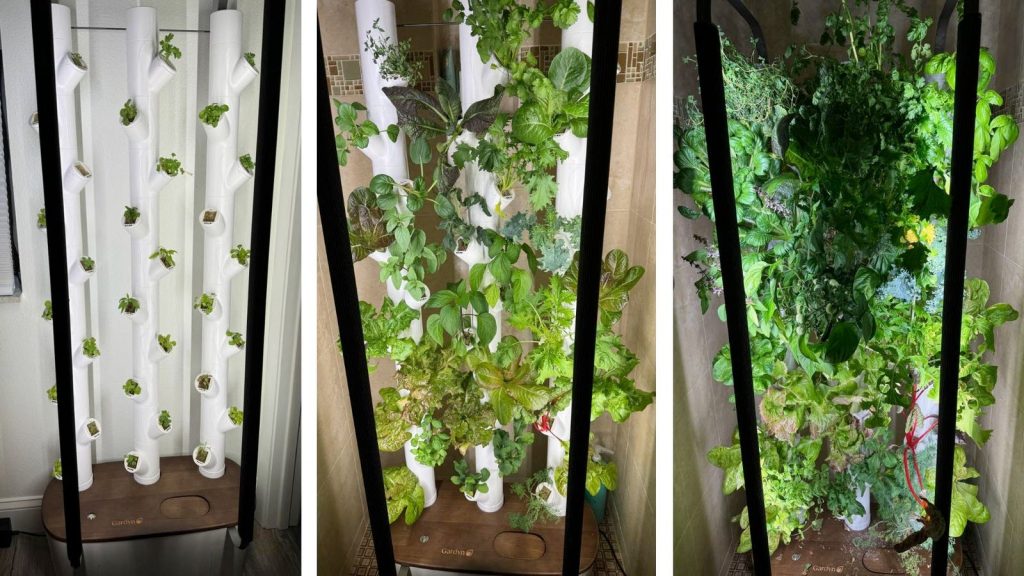I have the blackest of thumbs.
Anything I plant has a limited lifespan. Basically, however long it takes to use up whatever fertilizer that came with the soil it was germinated in. And don’t get me started on fruits and vegetables. I may, in a pique of manic interest, dig a half-assed plot and scatter some seeds but if they can’t make it on their own, those nascent plants have no chance of survival.
I tell you this because I’m not the person who should be reviewing a hydroponic garden setup. It should be someone who weeps as they tuck their garden beds in for the cold winter. Who spend the dark months picking out seeds and planning plots. Who love gardening so much that they almost can’t bear those times of the year when they’re not growing something.
But then again…I’ve spent the better part of the past few weeks maintaining two thriving indoor gardens. I haven’t had to buy (and ignore) a pack of mixed greens from the grocery store in weeks. I’m contemplating what I’ll use my fresh tomatoes and jalapenos for come December.
Against my herbicidal nature, I’ve become a gardener. All it took was a lot of technology.
Enter Gardyn And Auk
Back when summer was winding down, Gardyn and Auk, makers of two very different hydroponic gardens reached out, wanting me to give their latest hardware a spin.
Gardyn Home Kit 3.0 is a sizeable three-towered hydroponic garden that uses an integrated pump to get water and plant food to up to 30 plants at a time. With two integrated grow lights and cameras, you use a connected app and a helpful AI assistant to keep your little ecosystem up and running and your plants happy.
Auk is a much smaller affair, with six trays that you fill with soil and seeds. The trick here is that Auk does the feeding and watering for you, based on what you’ve identified as growing in your garden, with a full-spectrum light to give your sprouts the best chance.
Two very different approaches, each with their own limitations, but both will reward you in the same way.
…with more basil than you know what to do with.
Setting Up
Setting up the Gardyn is a process. It isn’t hard but it is bulky, with vertical columns and lights and the water reservoir and stabilizer straps. You’ll get the impression very quickly (probably upon unboxing it) that this is a serious piece of hardware. It’s also a very nice piece of hardware, with wood accents and clean lines. You won’t mind keeping it somewhere to show it off…though keep in mind the full spectrum light bars are bright.
The most crucial part (and the part that I glossed over) is researching your plants in the Gardyn app so that you can place the pre-planted Ycubes in spots on the towers where they’ll be the most successful (and won’t block out their neighbors). The app has a virtual assistant, Kelby, that keeps an eye on your water levels and plant growth (more on that in a bit). But the Garden Book is arguably even more important.
The Garden Book section of the app has tons of information, not just limited to care and harvesting tips, but also usage and history of the plant itself. My only wish is that you could bookmark the plants that you have currently growing in your Gardyn. Especially if you have a wide variety, the number of plants the company has available makes it a bit of a pain to just hop around and read up on each one.
Auk has a much simpler process. Once you assemble the hardware, you plant your seeds (they don’t come pre-planted like Gardyn’s Ycubes), fill the reservoir with water, and place your plant chip on the reader. This little RFID chip tells Auk what’s being grown and the device makes the necessary adjustments: watering and adding plant food as needed.
There’s no app to help you, so you’ll need to know a bit about what you’re planting so you don’t have a situation where your parsley is taking over your garden and blocking out the light from the full spectrum light bar. The nice thing is that you can plant whatever you want.
Waiting Is The Hardest Part
Once you get your hydroponic gardens set up and working properly, it’s time to settle in. Most plants have a germination period of 5-10 days before you’ll see the first sprout. Which can be frustrating but also gives you time to go through the extensive plant notes in the Gardyn app.
But once things take off? You’ll be rewarded with more produce and herbs and veggies than you know what to do with. Gardyn’s Kelby assistant walks you through trimming back new growth so that your Ycubes don’t get overcrowded. Kelby is doing other things behind the scenes as well, tailoring your watering and light schedule for optimal growth. It even can slow growth for up to two weeks when you go on vacation (a nice trick that means you won’t come back to a dead garden).
Auk doesn’t have the app or assistant that Gardyn does, but still provides impressive results. All you have to do is keep the water reservoir topped off and the plant food containers full. You’ll also need to harvest…a lot. Since Auk recommends germinating dozens of seeds at once, you’ll have a bumper crop to contend with.
As far as ongoing care…eventually for Auk you’ll need to retire your plants and get new ones growing, but that’s as simple as refilling the trays with new planting medium, dropping seeds in, and putting the right chip on the reader (Auk has a tomato & chili chip in addition to the herbs & salad chip). Depending on what you’re growing, you might need taller dowels as well for the light bar.
My issue with the Gardyn system is that it’s expensive to go all in. “But wait,” you say “I already spent $900 on an AI-powered hydroponic gardening system and plants, isn’t that enough?” Yes and no. The base Gardyn hardware does everything you expect but the plants themselves can be unpredictable. Sometimes your Ycubes don’t germinate all at the same time. When that happens, you’re left with a Sophie’s Choice of either adding plant food that will kill your still-germinating plants or starving your rapidly growing ones of the food they need to keep developing.
The solution? An $80 Ycube “nursery” that’ll give your slow swimmers the time they need to catch up while you add plant food to the system. It’s a great solution, but it shouldn’t be an add-on, especially given the mercurial nature of gardening.
Then there’s pump and tank maintenance. You have to clean the tank on a regular basis to avoid unwanted bacterial growth, which means breaking down and carefully washing your system. Or you could simply pour in some Hydroboost—a $49 add-on that takes care of things for you. Again, it’s something that’s necessary to keep your Gardyn running well and producing healthy plants, so why does Gardyn make you pay for it?
The nickel-and-dimming would make more sense to me if Gardyn didn’t have a subscription model…but they do. They charge members $40 a month but the credits provided are only good for additional plants, not accessories and maintenance items. It’s a confusing limitation.
And there are accessories galore. There are trellises for vining plants, different color Ycubes, a rolling platform for your whole Gardyn, the list goes on. As much as you’ll spend getting Gardyn initially, you can easily spend that much again (or more) in accessories and additional hardware.
Which To Get?
Gardyn is obviously the high-budget solution if you want to grow a versatile crop of plants, vegetables, even flowers. They have a voluminous catalog of plants to choose from and enough accessories that you can turn your Gardyn into pretty much whatever you want it to be. The Kelby AI assistant is rather helpful as well, keeping you abreast of what needs to be done on a regular basis (much appreciated for forgetful gardeners like myself).
The Gardyn Home Kit 3.0 is $719 right now for Black Friday (usually $999) and comes with 30 plants and plant food to get you started. You’ll want to throw some Hydroboost and a plant nursery in your cart as well.
Auk is for those who don’t have a spare 2 feet of floor space, or just want something more low-key for their countertop. While it’s less complex and not quite as versatile as Gardyn, it’s still quite capable and will keep you in lettuces, herbs, tomatoes, and chilis all winter long. It’s $259 for Black Friday (usually $369).
Read the full article here










